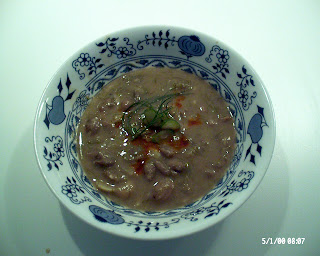
Don’t be quick to discard old bread; so long as it hasn’t become moldy, it can still be put to good use. Using bread slices in lieu of pasta to separate the layers of lasagna is one of the many ways to revive stale bread. It’s a clever twist on a classic Italian dish: the bread soaks up the sweet tomato sauces, becoming slightly moist while retaining its shape, texture and chewiness. And in between these slices of bread sits a colorful medley of melted mozzarella and Parmesan cheese, and flour-dredged and egg-battered fried zucchini strips. You’ll never again underestimate stale bread.
Note on the bread: For this dish, I recommend a hearty, chewy peasant’s bread. At my neighborhood Merkator, I purchase malnar, which is a light and chewy wheat bread, similar to but slightly bit denser than ciabatta. I’ve never tried this dish with pre-sliced loaves of bread, though I am sure it will work, so long as the bread you’re using has some density. Since pre-sliced breads are so thin, you’ll need to use slightly less sauce so that the bread does not become too soggy.
Ingredients:
1) Follow this recipe to fry the zucchini.
2) If you have prepared and frozen some sweet tomato sauce, set it to defrost in the fridge the night before you plan to make this lasagna. Otherwise, prepare a fresh batch using this recipe.
3) Cut the bread into ½ inch slices. The amount of bread you will require depends on the size of your casserole dish. The casserole dish that I use at home measures 7½ by 7½ inches, with a depth of about 4 inches. I managed to fit in two layers of bread, which required a little more than ½ a loaf of malnar.
4) Coarsely grate the mozzarella cheese, so that it is crumbly, and the Parmesan cheese. Toss the two cheeses together and set aside.
5) Preheat the oven to 200° C.
6) Place the slices of bread on a baking sheet and allow them to toast for about five to ten minutes. You want the bread to dry out partially, so that the top and bottom sides are dry and crunchy while the inside is still a bit moist and chewy. This way, when it is time to layer and you pour over tomato sauce, the bread will absorb the sauce and become moist but not soggy.
7) Once the bread is out of the oven, allow it to cool for five minutes. Then you can start layering.
8) Coat your casserole dish with a thin film of olive oil. Ladle out some tomato sauce and spread it over the bottom of the dish. You want only a thin layer of sauce on the base; you should be able to see through it to the base of the casserole dish.
9) Now cover the layer of sauce with slices of bread. You need not worry about covering every empty spot with a piece of bread.
10) Then begin to layer the strips of zucchini. I like doubling up on the zucchini, so that after the first layer of strips, I scatter some more tomato sauce, then I start placing the next layer of zucchini over that.
11) Scatter a generous handful of the cheese mixture over the zucchini, then cover with another layer of zucchini.
12) Top with some tomato sauce, then cover with more slices of bread. This is the second layer and last layer of bread.
13) Spoon some more tomato sauce over the bread, and then cover with yet another layer of zucchini.
14) Over this final layer of zucchini, scatter another generous handful of the cheese mixture.
15) Cover the final layer of cheese with the finely powdered or the crouton-sized breadcrumbs. I used the larger variety because that was what I had handy, though normally, I like using a mix.
16) Then set to bake in the oven for 15 minutes. Check intermittently to make sure the top layer of breadcrumbs does not burn. Keep in mind that all parts of the lasagna are already cooked, so the only purpose for baking it at the end is for the cheese to melt and the flavors to meld. Once you see that the cheese has melted, it is can be taken out of the oven.
17) Let the lasagna cool for about 5 minutes so that it does not fall apart when you cut it and serve it.
This recipe has been adapted from Lidia Bastianich’s cookbook, “Lidia’s Family Table.”

































